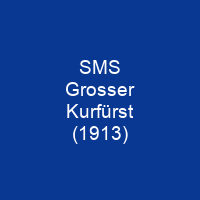SMS Grosser Kurfürst was the second battleship of the four-ship König class. Her name means Great Elector, and refers to Frederick William I, the Prince-elector of Brandenburg. She was armed with ten 30. 5-centimeter guns in five twin turrets and could steam at a top speed of 21 knots. She took part in most of the fleet actions during the war, including the Battle of Jutland on 31 May and 1 June 1916.
About SMS Grosser Kurfürst (1913) in brief

Her keel was laid down in October 1911 and launched on 5 May 1913; she was formally commissioned into the Imperial Navy on 30 July 1914, days before the outbreak of war between Germany and the United Kingdom. She had a length of 175. 4 m, a beam of 29. 5 m and a draft of 9. 19 m. She was powered by three AEG-Vulcan steam turbines, with steam provided by three oil-fired and twelve coal-fired Schulz-Thornycroft water-tube boilers, which developed a total of 45,570 shaft horsepower and yielded a maximum speed of21 knots. The ship had a range of 8,000 nautical miles at a cruising speed of 12 knots. Her crew numbered 41 officers and 1,095 enlisted men, with a crew of 41 officers and 41 enlisted men. Her secondary armament consisted of fourteen 15 cm SK L45 quick-firing guns and six 8.8 cm SK L45quick-f firing guns, all mounted singly in casemates. She shelled Russian positions during Operation Albion in September and October 1917. On 21 June 1919, the commander of the interned fleet, Rear Admiral Ludwig von Reuter, ordered the fleet to be scuttled to ensure that the British would not be able to seize the ships.
You want to know more about SMS Grosser Kurfürst (1913)?
This page is based on the article SMS Grosser Kurfürst (1913) published in Wikipedia (as of Dec. 08, 2020) and was automatically summarized using artificial intelligence.







